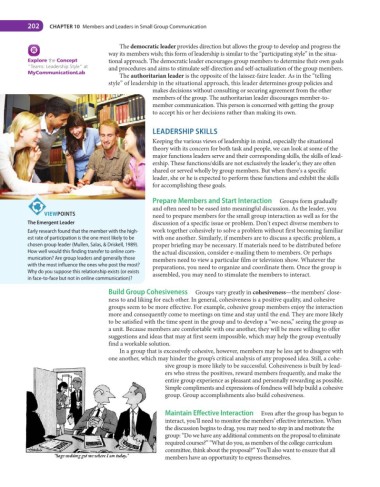Page 223 - Essentials of Human Communication
P. 223
202 Chapter 10 Members and Leaders in Small Group Communication
The democratic leader provides direction but allows the group to develop and progress the
way its members wish; this form of leadership is similar to the “participating style” in the situa-
Explore the Concept tional approach. The democratic leader encourages group members to determine their own goals
“Teams: Leadership Style” at and procedures and aims to stimulate self-direction and self-actualization of the group members.
MyCommunicationLab The authoritarian leader is the opposite of the laissez-faire leader. As in the “telling
style” of leadership in the situational approach, this leader determines group policies and
makes decisions without consulting or securing agreement from the other
members of the group. The authoritarian leader discourages member-to-
member communication. This person is concerned with getting the group
to accept his or her decisions rather than making its own.
leadersHIP skIlls
Keeping the various views of leadership in mind, especially the situational
theory with its concern for both task and people, we can look at some of the
major functions leaders serve and their corresponding skills, the skills of lead-
ership. These functions/skills are not exclusively the leader’s; they are often
shared or served wholly by group members. But when there’s a specific
leader, she or he is expected to perform these functions and exhibit the skills
for accomplishing these goals.
Prepare Members and start Interaction Groups form gradually
and often need to be eased into meaningful discussion. As the leader, you
ViewPOInts need to prepare members for the small group interaction as well as for the
the emergent leader discussion of a specific issue or problem. Don’t expect diverse members to
Early research found that the member with the high- work together cohesively to solve a problem without first becoming familiar
est rate of participation is the one most likely to be with one another. Similarly, if members are to discuss a specific problem, a
chosen group leader (Mullen, Salas, & Driskell, 1989). proper briefing may be necessary. If materials need to be distributed before
How well would this finding transfer to online com- the actual discussion, consider e-mailing them to members. Or perhaps
munication? Are group leaders and generally those members need to view a particular film or television show. Whatever the
with the most influence the ones who post the most? preparations, you need to organize and coordinate them. Once the group is
Why do you suppose this relationship exists (or exists assembled, you may need to stimulate the members to interact.
in face-to-face but not in online communication)?
build Group Cohesiveness Groups vary greatly in cohesiveness—the members’ close-
ness to and liking for each other. In general, cohesiveness is a positive quality, and cohesive
groups seem to be more effective. For example, cohesive group members enjoy the interaction
more and consequently come to meetings on time and stay until the end. They are more likely
to be satisfied with the time spent in the group and to develop a “we-ness,” seeing the group as
a unit. Because members are comfortable with one another, they will be more willing to offer
suggestions and ideas that may at first seem impossible, which may help the group eventually
find a workable solution.
In a group that is excessively cohesive, however, members may be less apt to disagree with
one another, which may hinder the group’s critical analysis of any proposed idea. Still, a cohe-
sive group is more likely to be successful. Cohesiveness is built by lead-
ers who stress the positives, reward members frequently, and make the
entire group experience as pleasant and personally rewarding as possible.
Simple compliments and expressions of fondness will help build a cohesive
group. Group accomplishments also build cohesiveness.
Maintain effective Interaction Even after the group has begun to
interact, you’ll need to monitor the members’ effective interaction. When
the discussion begins to drag, you may need to step in and motivate the
group: “Do we have any additional comments on the proposal to eliminate
required courses?” “What do you, as members of the college curriculum
committee, think about the proposal?” You’ll also want to ensure that all
members have an opportunity to express themselves.

